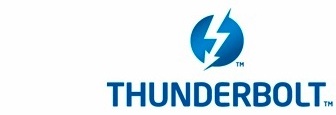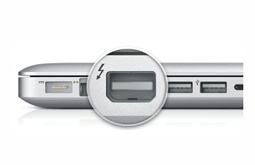


Thunderbolt offers maximum mobility and ultra-high speed bandwidth when used with compatible storage devices, docks, and high-resolution displays. Thunderbolt technology features 10Gbps, dual channel, bi-directional bandwidth while supporting data and video over a single cable. Thunderbolt technology combines PCI Express and DisplayPort I/O protocols into a single port. Up to six devices can be daisy-chained over a single Thunderbolt host port. The advanced features of Thunderbolt technology will bring high performance storage capabilities to MacBook Air, MacBook Pro, iMac, Mac mini and soon Windows notebooks.


When thinking about how Thunderbolt works, it's probably easiest to compare it to the function of existing hardware.
The PCIe 2.0 bus found inside the Mac Pro offers high bandwidth expansion slots for adding storage or video cards. Thunderbolt provides this same PCIe 2.0 bus function for connecting external expansion devices. While customers
are usually familiar with installing an expansion card inside the Mac Pro they may not realize Thunderbolt peripherals require the same type of controller chipset found on a PCIe card, to now be built inside the Thunderbolt device. Essentially, Thunderbolt offers a high speed bus that supports both PCI Express and DisplayPort connectivity with maximum flexibility and simplicity on a single cable. Being able to connect a monitor and a data storage device to the same cable is a nice feature. As Thunderbolt is only a bus any controller chip that could have been used on a PCIe 2.0 expansion card is now a possible candidate for use with Thunderbolt. As an example, Thunderbolt peripherals could be based on eSATA, SAS, Fibre Channel,10Gb Ethernet, FireWire, USB and video based interfaces. As eSATA enclosures are very popular, a high quality Thunderbolt to eSATA adapter could provide a speedy interface for legacy eSATA enclosures.


Thunderbolt is 20 times faster than USB 2.0. This can be attributed
to the dual-channel design, which offers 10Gbps bi-directional data transfers on each channel. Thunderbolt can support data and/or a video display. These advanced features make Thunderbolt the professional choice for ultra-high speed data throughput and ultra-flexible video capture and playback configurations.
"Thunderbolt and the Thunderbolt logo are trademarks of Intel Corporation in the U.S. and/or other countries."

With High-Speed I/O performance, there is plenty of bandwidth
to daisy-chain up to six Thunderbolt external devices and a
Thunderbolt display at the end of the chain.


Thunderbolt devices can be bus powered (up to 10 watts) when used with a copper Thunderbolt cable of up to 3 meters
in length. When bus power is required, daisy chaining multiple Thunderbolt devices is not recommended. Longer optical Thunderbolt cables, up to 50 meters are expected to be available soon. While Optical cables offer much longer lengths, they will not support bus power.

















